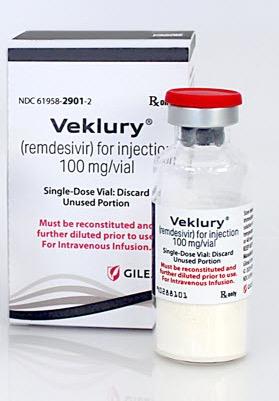Remdesivir Side Effects
Medically reviewed by Drugs.com. Last updated on Jul 13, 2024.
Applies to remdesivir: intravenous powder for solution, intravenous solution.
Precautions
It is very important that your doctor check your progress closely while you are receiving this medicine to make sure that it is working properly. Blood and urine tests may be needed to check for unwanted effects.
This medicine may cause serious allergic reactions, including infusion-related reactions and anaphylaxis, which can be life-threatening and require immediate medical attention. Tell your doctor right away if you start to have a fever, chill or shaking, dizziness, headache, hoarseness, increased sweating, trouble breathing, trouble swallowing, itching or skin rash, lightheadedness, fainting, fast, pounding, or uneven heartbeat, or any swelling of your hands, face, or mouth after receiving this medicine.
Do not receive remdesivir together with chloroquine phosphate or hydroxychloroquine sulfate.
Serious side effects of remdesivir
Along with its needed effects, remdesivir may cause some unwanted effects. Although not all of these side effects may occur, if they do occur they may need medical attention.
Check with your doctor or nurse immediately if any of the following side effects occur while taking remdesivir:
More common side effects
- back pain
- chest tightness
- chills
- cough
- dark-colored urine
- difficulty swallowing
- fast heartbeat
- fever
- flushing
- headache
- hives, itching
- light-colored stools
- nausea and vomiting
- puffiness or swelling of the eyelids or around the eyes, face, lips, or tongue
- stomach pain, continuing
- trouble breathing
- unusual tiredness or weakness
- yellow eyes or skin
Less common side effects
- seizures
- skin rash
Other side effects of remdesivir
Some side effects of remdesivir may occur that usually do not need medical attention. These side effects may go away during treatment as your body adjusts to the medicine. Also, your health care professional may be able to tell you about ways to prevent or reduce some of these side effects.
Check with your health care professional if any of the following side effects continue or are bothersome or if you have any questions about them:
More common side effects
- bleeding, blistering, burning, coldness, discoloration of skin, feeling of pressure, hives, infection, inflammation, itching, lumps, numbness, pain, rash, redness, scarring, soreness, stinging, swelling, tenderness, tingling, ulceration, or warmth at the injection site
See also:
For healthcare professionals
Applies to remdesivir: intravenous powder for injection, intravenous solution.
General adverse events
The most common side effects in patients with COVID-19 were nausea, increased AST, and increased ALT.[Ref]
Cardiovascular
- Uncommon (0.1% to 1%): Decreased heart rate
- Postmarketing reports: Sinus bradycardia
Sinus bradycardia generally normalized within 4 days after the last dose of this drug without additional intervention.
Dermatologic
- Common (1% to 10%): Rash
- Frequency not reported: Angioedema
Gastrointestinal
- Very common (10% or more): Increased lipase (up to 12%)
- Common (1% to 10%): Nausea, abdominal pain, diarrhea
Genitourinary
- Frequency not reported: Proteinuria, glycosuria
Hematologic
- Very common (10% or more): Decreased hemoglobin (up to 25%), decreased lymphocytes (up to 27%), increased prothrombin time (up to 11%)
- Common (1% to 10%): Increased prothrombin INR, increased thromboplastin time
- Frequency not reported: Prolonged INR, prolonged activated partial thromboplastin time, decreased WBC
In a clinical study of patients with COVID-19, the incidence of prolonged prothrombin time or INR (mostly less than 2 times the upper limit of normal [2 x ULN]) was higher with this drug compared to placebo; no difference was observed in the incidence of bleeding events between the 2 groups.
Hepatic
- Very common (10% or more): Increased transaminases
- Common (1% to 10%): Increased ALT, increased AST, increased bilirubin
- Uncommon (0.1% to 1%): Increased hepatic enzyme, hypertransaminasemia, increased liver function tests
- Frequency not reported: Hyperbilirubinemia, increased direct bilirubin
In studies in healthy subjects, increases in ALT, AST, or both in those who received this drug were 1.25 to 2.5 x ULN (10%) or 2.5 to 5 x ULN (4%). In clinical studies of patients with COVID-19, the incidence of increased transaminases was similar with this drug compared to placebo or standard of care.
Hypersensitivity
- Rare (0.01% to 0.1%): Hypersensitivity
- Frequency not reported: Anaphylaxis, anaphylactic shock
- Postmarketing reports: Anaphylactic reaction, hypersensitivity
Local
- Uncommon (0.1% to 1%): Injection site erythema
- Frequency not reported: Administration site extravasation
Metabolic
- Very common (10% or more): Increased glucose (up to 15%), increased uric acid (up to 11%)
Nervous system
- Common (1% to 10%): Headache
- Uncommon (0.1% to 1%): Seizure
- Frequency not reported: Generalized seizure
Other
- Very common (10% or more): Decreased albumin (up to 12%)
- Common (1% to 10%): Increased sodium, increased calcium
- Uncommon (0.1% to 1%): Infusion-related reactions, increased blood alkaline phosphatase
- Frequency not reported: Decreased potassium
Renal
- Very common (10% or more): Decreased CrCl (based on Cockcroft-Gault formula; up to 19%), decreased estimated glomerular filtration rate (eGFR; up to 18%), increased creatinine (up to 15%)
- Uncommon (0.1% to 1%): Decreased GFR, acute kidney injury
References
1. (2024) "Product Information. Veklury (remdesivir)." Gilead Sciences Ltd
2. (2024) "Product Information. Veklury (remdesivir)." Gilead Sciences, SUPPL-29
Frequently asked questions
More about remdesivir
- Check interactions
- Compare alternatives
- Reviews (39)
- Latest FDA alerts (3)
- Dosage information
- During pregnancy
- Drug class: purine nucleosides
- En español
Patient resources
Other brands
Professional resources
Other brands
Related treatment guides
Further information
Remdesivir side effects can vary depending on the individual. Always consult your healthcare provider to ensure the information displayed on this page applies to your personal circumstances.
Note: Medication side effects may be underreported. If you are experiencing side effects that are not listed, submit a report to the FDA by following this guide.

